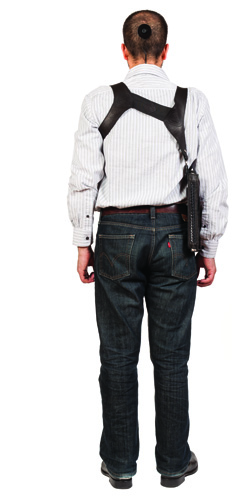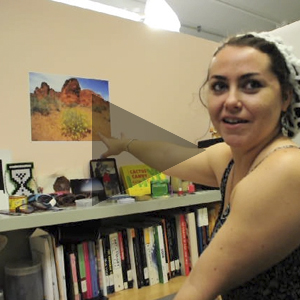Wafaa Bilal and The 3rd I Project

You click through screen after screen of blurred, obscure images, some of which are more recognizable than others (the top of a sofa, an alarm clock perched on a low table, the corner where two walls meet the ceiling, the ghostly form of a moving figure). They are all taken from an odd, slanted angle. A small frame pops up labeling each photograph with the day, the time to the second, and the latitude and longitude at which it was taken. These hard-to-read, banal images could be part of a neo-conceptual photo book, or they might have been culled from a government collection of surveillance photos.
In fact, these are photographs that were captured by the camera implanted in the back of artist Wafaa Bilal’s skull.
The jolting disharmony that exists between the quiet banality of the photos, and the startling sensationalism of the method by which they were produced, points to a whole host of tensions and contradictions in this former SAIC faculty member’s project, “The 3rd I.”
For this year-long performance piece (commissioned by the newly founded Mathaf: Arab Museum of Modern Art in Doha, Qatar), Bilal underwent a two-hour long operation. A body modification artist made an incision in Bilal’s scalp, lifted a three-inch flap of skin, and inserted three titanium plates beneath it. Metal posts attached to each plate pierced the skin and formed the mount for a digital camera.
Today, that camera automatically snaps a picture each minute, which streams live to the 3rd I website (and to LCD monitors in the Mathaf Museum). Each photo is updated with Bilal’s exact coordinates, as provided by the strap-on GPS unit that the artist wears at all times.
Although Bilal didn’t have the operation until December, the story broke in November and immediately caused a sensation. Articles have appeared in mainstream media outlets from The Wall Street Journal to The Huffington Post, and interviews broadcast on NPR’s On the Media and on CNN. Cheeky headlines declared, “NYU Professor Wafaa Bilal’s Hindsight is 20/20,” and “Meet Wafaa Bilal: The World’s First Internet-Connected, Photo-Taking Cyborg.”
“[The project] was leaked to The Journal before I had the chance to talk about it and say my objectives,” Bilal told F Newsmagazine, “so it instantly became part of pop culture, and the interest is really in the sensation behind it, a man and a camera in his head — that was what grabbed people’s attention. In the beginning that is what disappointed me, because there’s not much depth in that story, and of course it was reported everywhere in the news, and full attention was not given to the project itself.”
Of course, this sort of media attention is fairly de rigeur for Bilal — it seems that media spectacle is something he actively courts, as if it were an important element of his art. Some of his best known works (which typically draw from Bilal’s personal experiences as an Iraqi-American, as well as the 2004 death of his brother as the result of the American military offensive in Iraq) have garnered more attention from mainstream media sources than from art critics. Particularly sensational projects include “Domestic Tension” of 2007, where for one month Bilal took up residence in a gallery along with a paintball gun machine. Viewers could fire at the artist at will, 24 hours a day, simply by logging into a website.
Others include a 2008 project whereby internet voters could choose whether to waterboard a small dog or to waterboard Bilal himself (Bilal was the unfortunate winner of that dubious contest). “Virtual Jihadi” was a hack of a hack of a video game, in which the player could guide a Wafaa Bilal avatar on a suicide bomb mission to destroy George Bush. This particular piece was so controversial that the gallery at the Rensselaer Polytechnic Institute, where it was meant to be shown, cancelled the exhibition. And most recently, Bilal performed “…and counting,” a 24-hour body modification performance whereby the artist’s back was tattooed with a map of Iraq and small dots representing the casualties of the Iraq war (5,000 red dots to represent American soldiers, and 100,000 dots tattooed in green UV ink, visible only under black light, to represent Iraqi deaths).
These are projects that easily titillate raw political sensibilities, as well as the average citizen’s appetite for morbidity — and it’s easy to lose site of the artwork itself in the midst of all that provocation. F Newsmagazine spoke with Bilal in an attempt to wade through the scandal and assess the project itself.
The Project’s Inception
The idea for “The 3rd I” was conceived well before the Mathaf’s curators approached Bilal to participate in the “Told/Untold/Retold” exhibition in 2010.
“The project came from a deep desire to capture images of places we leave behind,” the artist told F. “Sometimes we leave these places by choice. And sometimes we’re forced. I first started thinking about it in 1991 when I left Iraq and my hometown [Najaf] was under bombardment by the Saddam regime. And that was the initial desire, to capture those images.
“But as I evolved in my thinking and practice, I came to understand that there is no such thing as an objective image. The image is always subjective, and is encoded by the photographer, and influenced by the photographer’s philosophy or their point of view. So then I started thinking I wanted to lose that subjectivity … and one way is to lose the power of our eyes through the view finder, and the power of our finger when we press the shutter. Because that’s when the encoding of the photograph takes place. So the only logical thing is to place this camera in the back of my head … it becomes logical to unite the camera with the body to create a shooting, biotechnological apparatus, and trying to lose as much subjectivity over the image [as possible].”
A Bold Curatorial Move
Bilal was unable to secure funding for the project until he was approached by Till Fellrath and Sam Bardaouil, directors of the art consulting agency Art Reoriented, which curated the “Told/Untold/Retold” exhibition at the Mathaf. Fellrath and Bardaouil invited 23 of the Middle East’s best known contemporary artists to participate, including internationally renowned artists like Lara Baladi, Amal Kenawy, Hassan Khan, Youssef Nabil, Walid Raad and Steve Sabella.
According to the curatorial statement, the exhibition was meant to feature multimedia work that focused on a narrative, whether that be of autobiographical memories, imagined futures or rewritten histories. “Central to each story,” the curators wrote, “is the use of time as a concrete compositional element and the reflection on the act of journeying.”
When the curators approached Bilal, he proposed several different ideas, but they insisted on “The 3rd I” — and, more importantly, offered the substantial funding required to complete the project. The choice was bold and risky; it would be hard to show this type of project, with its political commentary on surveillance, at other venues in the Middle East.
When asked if he experienced any pushback or institutional censorship, Bilal responded, “No, and that was to my surprise. It seems that Qatar is making really strong confident steps in opening up the community and bringing in uncensored voices. No artist has been censored [in this show], and this is a very promising thing that is taking place in that country, and hopefully it will be a ripple effect to the neighboring countries.
I did go to the opening, and the project was received very well. I was completely free to go anywhere in Qatar, I have not been stopped even once by security — with the exception of on my return. I was stopped at the airport when I was about to board an American plane, which is understandable … but other than that, the project was received very well, and I heard from multiple sources how happy and proud they are of a Middle Eastern artist making such a daring project.”
Inherent Contradictions?
Accolades and scandal aside, it’s difficult to get a firm grasp on this project, which is fraught with thorny conceptual tensions. Take Bilal’s insistence that the project was born of a desire to essentially erase himself from his own artistic process, to present a relentless series of images totally devoid of his own subjectivity. The goal of “subjectless-ness” seems at odds with the very personal, violent act the artist inflicted on his own body.
When asked to comment on this tension, Bilal responded, “I use the body as a tactic, and what I mean is, the body has its own language, and then the mind has its own language. What I’m trying to do is not only communicate to the viewer conceptually, but I’m also trying to engage the viewer visually, corporally, with their body, because the mind is all the time trying to put up barriers or justify reasons to not engage. But then when you see a body in motion, or a body being affected, you can’t help but engage immediately in that project, because your body reacts. … I am a participant, but the object is to engage the viewer as a participant.”
Bilal admits a debt to canonical body artists, like Chris Burden and Marina Abromovic, as well as body artists-cum-cyborgs like Stellarc and Steve Mann. And certainly, the artist’s desire to test his own physical limits (and by extension, he claims, the limits of the society in which he lives) fits within that lineage.
On the other hand, his work is far more expressly political. Bilal has consistently used his own body as a site of protest against specific political problems. In the context of the desperate acts of self-immolation that have recently take place in Tunisia, and then across the Middle East, Bilal’s work appears even more poignant — and urgent.
The artist says that “The 3rd I” is his most physically challenging project to date. Not only is the very act of constantly being wired (and constantly being aware of each movement) exhausting, but “you have also to consider the operation,” he said. “It continues to be a problem. It lasted two hours, but you have posts sticking out of my head to hold a camera, and these are going to be open an entire year, so there’s infection and complications and so on, and besides that, you have constant pain as well. So this has an accumulative effect on me, that’s really, really tough to endure, and I am already bracing myself for the next eleven months.”
When asked why this feat of endurance was important conceptually for the project, Bilal responded, “I was thinking, how do you resist the urge to turn around and take a picture; these are impulses we all have, and the ideas of recording, of witnessing, of being there. … I guess our lives become really mediated through technology, and the biggest challenge so far is, how do you resist the idea of turning around and taking these pictures — it’s hard, and that’s a test of will as well.”
Bilal was also asked to comment on the tension between his own personal experience of this act of endurance, and the “art object” that is left for the viewer to encounter: namely, the hundreds of very anonymous digital images streaming on his website. “I see them as a record,” he answered. “One of the hardest things you have of a performance is how you document it. I think these images become the record itself. I’m trying to remove myself from it, which is impossible. It’s going to give me a very good idea of what I’ve done so far this year, minute by minute.”
The Disappearing Artist
Clicking through the archive of images on The 3rd I website feels almost like an inversion of clicking through a Facebook photo gallery. Instead of photos brimming with booze-swelled ego and proud human subjectivity, these are images where the most mundane, trivial, ego-less details of daily life become the subject: forgotten corners, the bathroom ceiling, the wall behind your desk.
In the final analysis, despite the very ego-filled, personal nature of Bilal’s physical performance, the actual art objects that the viewer can encounter do seem to achieve (or nearly achieve) Bilal’s goal. If we look at the photos, we become witnesses to things the artist left behind, forgot, or doesn’t even know existed — things that are untouched by his subjective gaze. We are witnessing the artist’s literal disappearance.
Bilal says that this is going to be his last project — maybe. “I don’t know if I will stick to that promise or not,” he qualifies. “But I don’t have any other projects planned at the moment.
“The reason why is because as an artist, we don’t live in the moment. We’re always thinking about what we’ve done and what we’re going to do next. I was recently standing in the middle of Washington Square Park and I have never existed in the present as much as that moment. I wasn’t thinking about the next project or what happened in the past. I was truly in the present time, and I think that this is what this project is also about: being in the present, as mundane as it is, and absorbing it.”
See images at www.3rdi.me








This article provides insightful information on “Wafaa Bilal and The 3rd I Project.”
The essence of Bilal’s artwork is captured. And objective writing conveyed the idea quite well. Organization, tone, and schema were well-constructed. Perhaps, the pitch could have been pushed further. The first paragraph was not as strong and driven as the rest of the article. Four-stars!
I thought “A Disappearing Act” was quite informative and definitely an interesting read. It was effective to have the perspective of the project from the artist and the writers or viewer point of view. I do agree with Kevin that the first paragraph is not as strong as the rest of the article.
Wafaa Bilal is a very interesting as an artist. He seems to be one of the pioneers in “digital performance” art. Where users don’t even have to be present to be engaged with the artwork. I really like that he’s transcending the traditional proximity to the piece that most performance artists work with. The article was very insightful, and I felt like all questions I may have asked were answered!